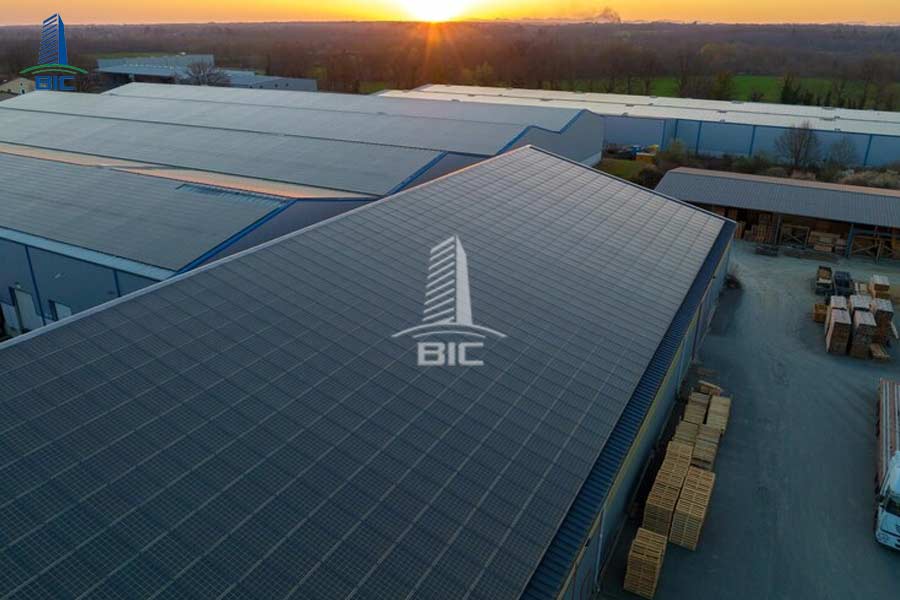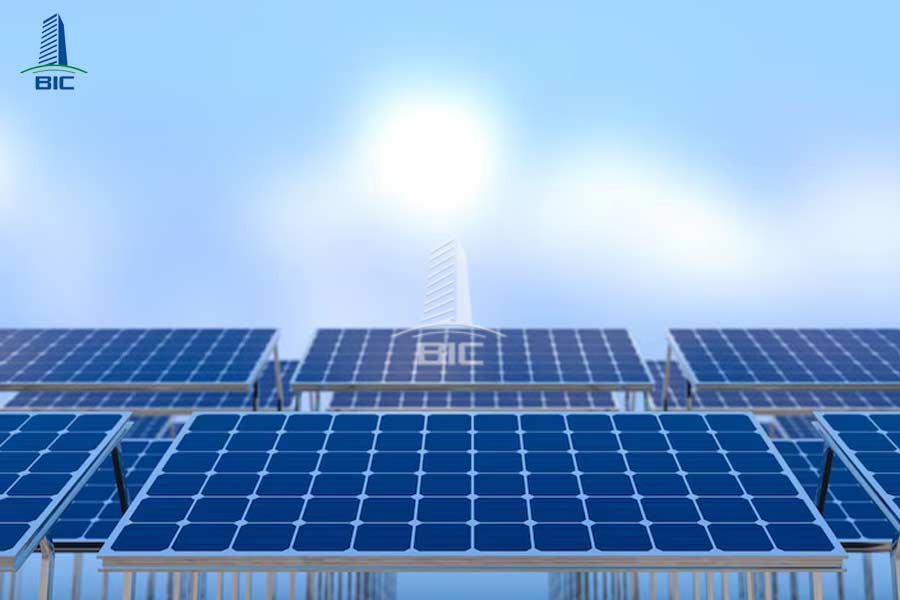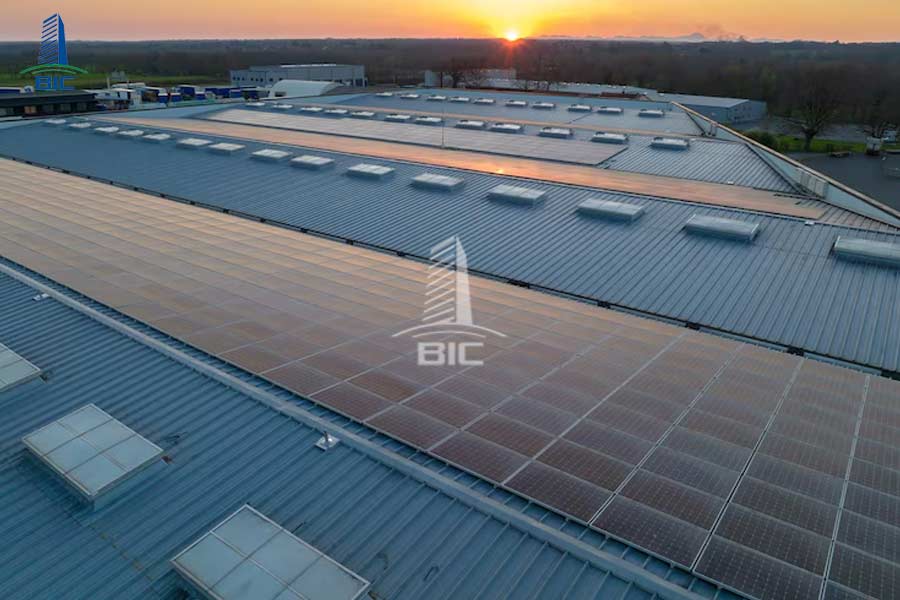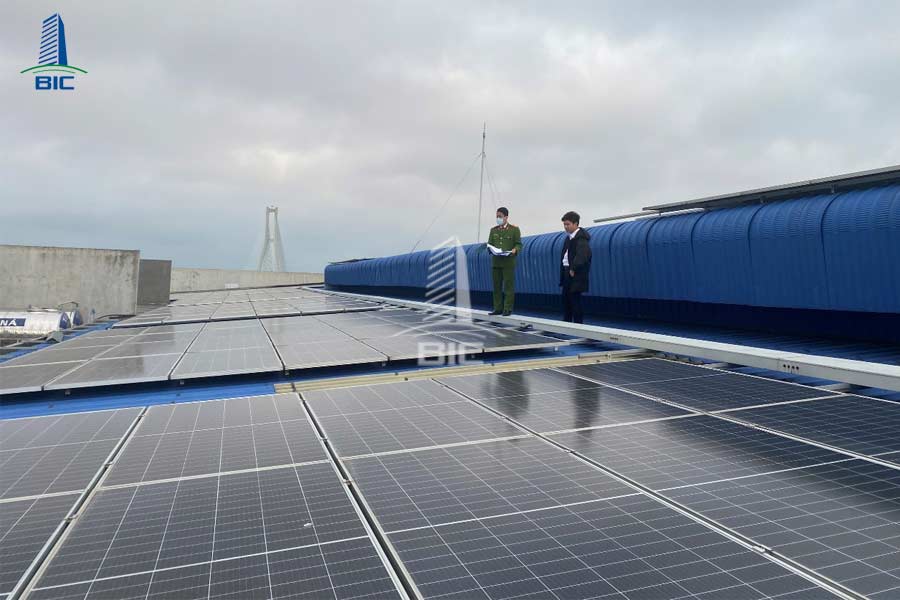
Modern factory design goes beyond just ensuring functionality and reasonable construction costs, it must also address energy efficiency and environmental sustainability. Amidst the global shift toward green manufacturing and increasing demands from international partners, integrating solar energy into factory design presents a smart and sustainable direction for businesses. No longer an optional extra, solar power is becoming a core element in helping modern factories cut operational costs, enhance brand value, and prepare for deep integration into global supply chains.
Applying solar energy in factories is now seen as a long-term strategy that allows businesses to take control of their energy expenses. Particularly for industries with high electricity consumption such as mechanical engineering, food processing, and garment manufacturing rooftop solar systems can reduce monthly electricity bills by 30–60%, thereby improving profit margins and boosting competitiveness.
This not only enhances short-term profitability but also mitigates long-term financial risks amid rising electricity prices and global energy costs.
Integrating renewable energy into factory design helps businesses meet environmental standards such as LEED, EDGE, and ISO 14001, offering a significant advantage in joining global supply chains. For investors and international partners, it demonstrates a company’s commitment to sustainable development an increasingly critical factor in long-term collaboration decisions.
Factory rooftops, being spacious, unobstructed, and well-ventilated, offer ideal conditions for installing solar panels without the need for expanding land use or changing the layout. Effectively utilizing this space increases the asset’s functional value and optimizes initial investment costs.

This is the most common model in Vietnam, suitable for most industrial facilities. The system is installed directly on the factory roof and connected to the national grid through inverters.
Key Benefits:
- Direct daytime use of solar power.
- Excess electricity can be sold back to EVN under the FIT (Feed-in Tariff) scheme.
- Investment costs are optimized by using available rooftops, with no need for storage systems.
Technical Requirements: Roof structures must be designed or reinforced to support the panels; the factory’s electrical system must be compatible with grid-tied configurations.
This model combines solar panels with battery storage systems, allowing stable operation during grid outages or peak hours when commercial electricity rates are high.
Ideal For:
- Factories operating 24/7 or with critical, non-stop production lines.
- Areas with unstable grid supply or frequent outages.
- Businesses seeking independence from EVN and more control over energy usage.
Advantages: Flexible operation, increased solar power efficiency, and the ability to disconnect from the grid when necessary.

This is the pinnacle of modern factory design: the total amount of electricity generated by the solar system is equal to or exceeds the annual electricity consumption.
Strategic Benefits:
- Near-zero carbon emissions.
- Meets stringent green supply chain requirements from global corporations.
- Strong advantage for ESG funding and public listings.
Requirements: Careful planning is needed from architectural and MEP design to energy systems and equipment to ensure efficiency, sustainability, and system compatibility. This is an ideal route for pioneering businesses in sustainability or new eco-industrial parks.
Determining the solar system’s capacity must be done during the design phase not post-construction. It should be based on actual energy consumption, future growth projections, roof orientation, available space, and expected ROI timeframe.
Proper upfront design helps avoid costly reinforcements or electrical system changes later and ensures optimal performance and payback.

Although solar panels aren’t overly heavy, installing a large number of them for long-term use especially in harsh weather requires a roof designed for structural strength, vibration resistance, corrosion resistance, and long-term stability.
Ignoring this can lead to sagging, roof damage, or even safety hazards during stormy seasons, resulting in asset losses and production disruptions.
Solar power systems must be seamlessly integrated into the factory’s main electrical system using inverters, control panels, and switches. This requires experienced designers to coordinate with MEP, fire protection, and automation systems to ensure:
- Power is distributed efficiently to different production areas.
- Protection systems are accurately installed to avoid overloads or leaks.
- The system can be expanded or connected to EVN reliably without affecting operations.

Solar investments are no longer experimental. They have shown clear effectiveness in major industrial parks across Vietnam. From VSIP and Long Hau to Hiep Phuoc, many factories have adopted rooftop solar models and quickly reaped financial and strategic sustainability benefits.
Notable outcomes include:
- 20–40% monthly electricity cost savings, significantly improving profit margins in the face of rising power prices.
- Higher environmental ratings during audits, especially important in global supply chains that demand strict green compliance.
- Enhanced ESG scores (Environmental – Social – Governance) in fundraising, IPOs, or accessing international green credit and sustainability funds.
These real-world successes demonstrate that solar-integrated factory design not only delivers immediate cost savings but also unlocks long-term development opportunities.
Solar-powered factory design is no longer an experimental concept, it’s fast becoming the new standard in modern industrial development. This strategic solution enables businesses to reduce operational expenses, enhance brand value, improve competitiveness, and stay ahead of the global green trend.
By investing right from the design stage, businesses can save hundreds of millions of VND annually while opening doors to high-standard markets and sustainability-minded partners.
Contact BIC a professional factory design and construction unit for expert consultation on optimal, integrated, and effective solar energy solutions starting from the very first blueprint.